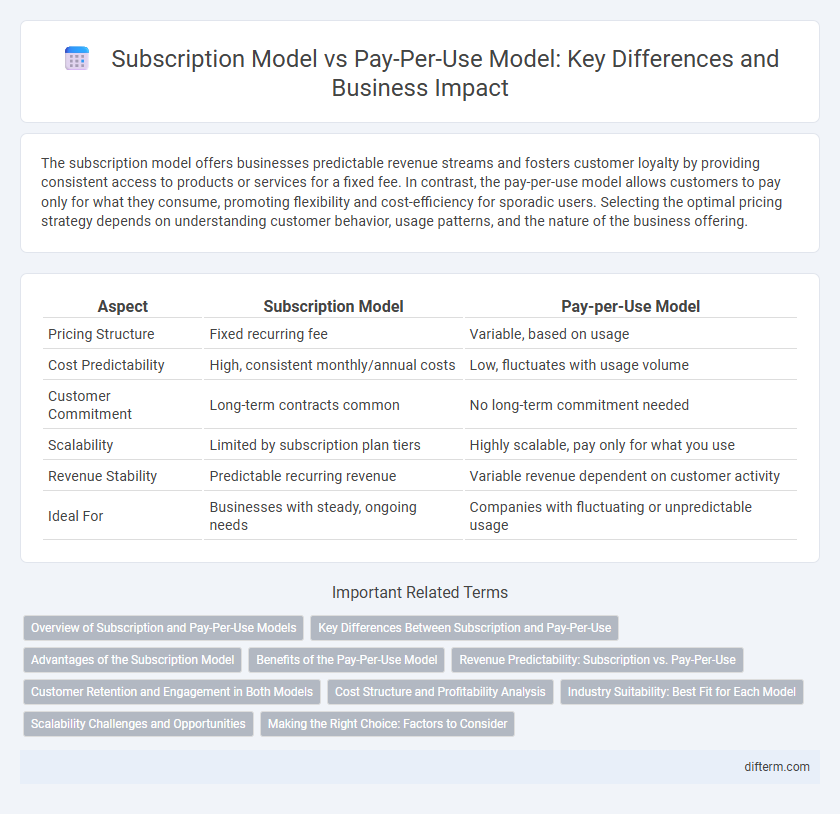The subscription model offers businesses predictable revenue streams and fosters customer loyalty by providing consistent access to products or services for a fixed fee. In contrast, the pay-per-use model allows customers to pay only for what they consume, promoting flexibility and cost-efficiency for sporadic users. Selecting the optimal pricing strategy depends on understanding customer behavior, usage patterns, and the nature of the business offering.
Table of Comparison
| Aspect | Subscription Model | Pay-per-Use Model |
|---|---|---|
| Pricing Structure | Fixed recurring fee | Variable, based on usage |
| Cost Predictability | High, consistent monthly/annual costs | Low, fluctuates with usage volume |
| Customer Commitment | Long-term contracts common | No long-term commitment needed |
| Scalability | Limited by subscription plan tiers | Highly scalable, pay only for what you use |
| Revenue Stability | Predictable recurring revenue | Variable revenue dependent on customer activity |
| Ideal For | Businesses with steady, ongoing needs | Companies with fluctuating or unpredictable usage |
Overview of Subscription and Pay-Per-Use Models
Subscription models generate consistent revenue by charging customers a recurring fee for unlimited or tiered access to products or services, enhancing customer retention and predictable cash flow. Pay-per-use models offer flexible, usage-based pricing where customers pay only for what they consume, attracting cost-sensitive users and optimizing resource allocation. Businesses choose subscription models for stable income streams, while pay-per-use models align costs with actual demand and consumption patterns.
Key Differences Between Subscription and Pay-Per-Use
Subscription models guarantee predictable revenue through fixed periodic payments, enhancing cash flow stability and customer retention rates. Pay-per-use models offer flexibility by charging customers based on actual consumption, appealing to variable or infrequent usage patterns and reducing upfront costs. The key difference lies in billing structure: subscriptions emphasize consistent, recurring charges, while pay-per-use prioritizes usage-based, variable pricing aligned with demand fluctuations.
Advantages of the Subscription Model
The subscription model offers predictable recurring revenue and enhances customer retention by fostering long-term relationships. It enables businesses to better forecast cash flow and invest in product improvements while providing customers continuous value and convenience. This model often results in higher lifetime customer value compared to pay-per-use models.
Benefits of the Pay-Per-Use Model
The pay-per-use model offers businesses enhanced cost efficiency by allowing payments strictly based on actual consumption, minimizing upfront investments and reducing financial risk. This model provides greater flexibility and scalability, enabling companies to adjust their usage according to demand fluctuations without long-term commitments. Real-time usage tracking and transparent billing improve budget management and encourage responsible resource utilization.
Revenue Predictability: Subscription vs. Pay-Per-Use
Subscription models offer consistent revenue streams through fixed recurring payments, enhancing cash flow predictability for businesses. In contrast, pay-per-use models generate variable income dependent on customer usage patterns, which can lead to fluctuating revenue and increased financial uncertainty. Companies prioritizing stable forecasting and budgeting often favor subscription models due to their reliable revenue predictability.
Customer Retention and Engagement in Both Models
Subscription models enhance customer retention by offering predictable billing and ongoing value through continuous access to products or services, fostering habitual engagement. Pay-per-use models drive engagement by allowing customers to pay solely for what they utilize, appealing to those seeking flexibility and cost control, which can lead to variable but potentially less consistent retention. Both models benefit from personalized experiences and data-driven insights to optimize customer satisfaction and long-term loyalty.
Cost Structure and Profitability Analysis
Subscription models offer predictable revenue streams and lower customer acquisition costs by fostering long-term relationships, which enhances profitability through consistent cash flow and reduced churn rates. In contrast, pay-per-use models generate variable income based on customer activity, leading to fluctuating cash flows and higher administrative expenses due to transaction processing and usage tracking. Cost structures in subscription models emphasize fixed infrastructure and customer retention investments, whereas pay-per-use models incur relatively low fixed costs but higher variable expenses proportional to usage intensity.
Industry Suitability: Best Fit for Each Model
Subscription models are best suited for industries with predictable, recurring needs such as software-as-a-service (SaaS), streaming platforms, and digital content providers, where consistent revenue streams are crucial. Pay-per-use models thrive in industries like cloud computing, utilities, and telecommunications, where consumption varies significantly and clients prefer flexibility in billing. Businesses in sectors with fluctuating demand benefit from pay-per-use, while those requiring steady resource access favor subscription for cost stability and customer retention.
Scalability Challenges and Opportunities
Subscription models offer predictable recurring revenue but face scalability challenges such as customer churn and infrastructure demands during rapid growth. Pay-per-use models provide flexibility and align costs with usage, presenting opportunities for scalable revenue tied directly to demand fluctuations. Balancing operational efficiency and customer acquisition costs remains critical to overcoming scalability barriers in both pricing strategies.
Making the Right Choice: Factors to Consider
Evaluating customer behavior and usage patterns is critical when choosing between a subscription model and a pay-per-use model, as predictable demand often favors subscriptions, while sporadic use aligns better with pay-per-use. Financial goals such as recurring revenue stability versus maximizing short-term profits should guide the decision, alongside operational capabilities including billing infrastructure and customer support scalability. Market analysis on competitor pricing strategies and customer preferences also plays a key role in determining the optimal monetization model for sustained business growth.
subscription model vs pay-per-use model Infographic

 difterm.com
difterm.com